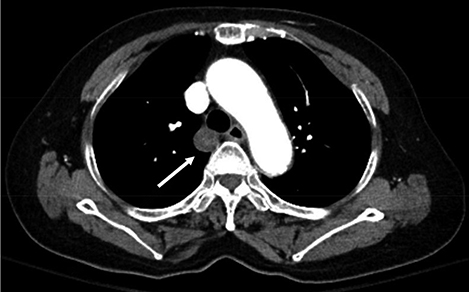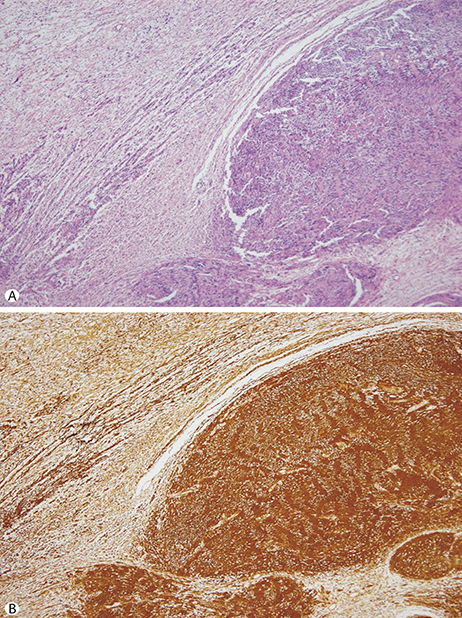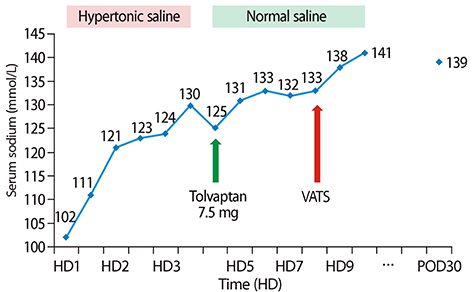Electrolyte Blood Press.
2017 Dec;15(2):42-46. 10.5049/EBP.2017.15.2.42.
Syndrome of Inappropriate Antidiuretic Hormone Secretion (SIADH) Associated with Mediastinal Schwannoma
- Affiliations
-
- 1Department of Internal Medicine, Dongtan Sacred Heart Hospital, Hallym University College of Medicine, Hwaseong, Korea. sinani28@hanmail.net, kjr@hallym.or.kr
- 2Department of Pathology, Dongtan Sacred Heart Hospital, Hallym University College of Medicine, Hwaseong, Korea.
- KMID: 2401152
- DOI: http://doi.org/10.5049/EBP.2017.15.2.42
Abstract
- Syndrome of inappropriate antidiuretic hormone secretion (SIADH) is the most common cause of euvolemic hypo-osmotic hyponatremia. There are several etiologies of SIADH including neuroendocrine tumor, pulmonary disease, infection, trauma, and medications. Here, we report a case of SIADH associated with a schwannoma involving the mediastinum in a 75-year-old woman who presented with nausea, vomiting, and general weakness. Laboratory testing showed hypo-osmolar hyponatremia, with a serum sodium level of 102mmol/L, serum osmolality of 221mOsm/kg, urine osmolality of 382mOsm/kg, urine sodium of 55 mmol/L, and plasma antidiuretic hormone (ADH) of 4.40 pg/mL. Chest computed tomography identified a 1.5-cm-sized solid enhancing nodule in the right lower paratracheal area. A biopsy specimen was obtained by video-assisted thoracoscopic surgery, which was diagnosed on pathology as a schwannoma. The hyponatremia was completely resolved after schwannoma resection and plasma ADH level decreased from 4.40 pg/mL to 0.86 pg/mL. This case highlights the importance of suspecting and identifying the underlying cause of SIADH when faced with refractory or recurrent hyponatremia, and that on possibility is mediastinal schwannoma
MeSH Terms
Figure
Reference
-
1. Spasovski G, Vanholder R, Allolio B, et al. Clinical practice guideline on diagnosis and treatment of hyponatraemia. Eur J Endocrinol. 2014; 170:G1–G47.
Article2. Ellison DH, Berl T. Clinical practice. The syndrome of inappropriate antidiuresis. N Engl J Med. 2007; 356:2064–2072.3. Miller M, Hecker MS, Friedlander DA, Carter JM. Apparent idiopathic hyponatremia in an ambulatory geriatric population. J Am Geriatr Soc. 1996; 44:404–408.
Article4. Anpalahan M. Chronic idiopathic hyponatremia in older people due to syndrome of inappropriate antidiuretic hormone secretion (SIADH) possibly related to aging. J Am Geriatr Soc. 2001; 49:788–792.
Article5. Strollo DC, Rosado-de-Christenson ML, Jett JR. Primary mediastinal tumors: part II. Tumors of the middle and posterior mediastinum. Chest. 1997; 112:1344–1357.6. Pitale SU, Lee JM, Origitano T, Emanuele NV. An unusual pituitary mass presenting with panhypopituitarism and hyponatraemia. Postgrad Med J. 2001; 77:530–531. 539–540.
Article7. Bernreuther C, Flitsch J, Ludecke DK, Hagel C. A 61-year-old man with hyponatremia. Brain Pathol. 2008; 18:283–287.8. Koch CA, Fulop T. Clinical aspects of changes in water and sodium homeostasis in the elderly. Reviews in Endocrine and Metabolic Disorders. 2017; 18:49–66.
Article9. Verbalis JG, Goldsmith SR, Greenberg A, et al. Diagnosis, evaluation, and treatment of hyponatremia: expert panel recommendations. Am J Med. 2013; 126:S1–S42.
Article10. Marchevsky AM. Mediastinal tumors of peripheral nervous system origin. Semin Diagn Pathol. 1999; 16:65–78.11. Ingels GW, Campbell DC Jr, Giampetro AM, Kozub RE, Bentlage CH. Malignant schwannomas of the mediastinum. Report of two cases and review of the literature. Cancer. 1971; 27:1190–1201.
Article12. Aughenbaugh GL. Thoracic manifestations of neurocutaneous diseases. Radiol Clin North Am. 1984; 22:741–756.13. Gale AW, Jelihovsky T, Grant AF, Leckie BD, Nicks R. Neurogenic tumors of the mediastinum. Ann Thorac Surg. 1974; 17:434–443.
Article14. Khanlou H, Khanlou N, Eiger G. Schwannoma of posterior mediastinum: a case report and concise review. Heart Lung. 1998; 27:344–347.
Article15. Kim ER, Choi EO, Lee KB, Kang CH, Kim YT, Park IK. A recurrent cellular schwannoma. Korean J Thorac Cardiovasc Surg. 2014; 47:487–490.
Article
- Full Text Links
- Actions
-
Cited
- CITED
-
- Close
- Share
- Similar articles
-
- A case of syndrome of inappropriate secretion of antidiuretic hormone associated with paroxetine
- The Effect of Demeclocycline on the Management of Syndrome of Inappropriate Secretion of Antidiuretic Hormone in Brain Injured Patient
- A Case Report of Syndrome of Inappropriate Antidiuretic Hormone Induced by Pregabalin
- A Case of Syndrome of Inappropriate Antidiuretic Hormone Secretion and Pneumomediastinum Complicated by Bougienation in Malignant Esophageal Stricture
- Case of Syndrome of Inappropriate Antidiuretic Hormone Secretion in a Patient with Esophageal Cancer




